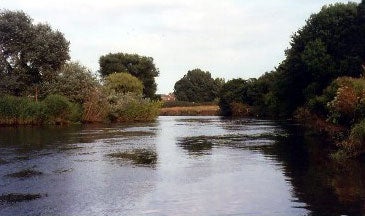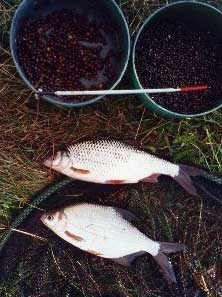| MARK WINTLE |
| Mark Wintle, an angler for thirty-five years, is on a quest to discover and bring to you the magic of fishing. Previously heavily involved with match fishing he now fishes for the sheer fun of it. With an open and enquiring mind, each week Mark will bring to you articles on fishing different rivers, different methods and what makes rivers, and occasionally stillwaters, tick. Add to this a mixed bag of articles on catching big fish, tackle design, angling politics and a few surprises. Are you stuck in a rut fishing the same swim every week? Do you dare to try something different and see a whole new world of angling open up? Yes? Then read Mark Wintle’s regular weekly column. |
LATE SUMMER ROACH ON HEMP AND TARES
| As a keen roach angler I love my winter roach fishing. But rather than wait until November I sought out an opportunity for some summer roach sport, although summer has its frustrations for the roach angler. Apart from the increased disturbance from boats, dogs and swimmers, the multitude of tiddlers can make catching roach tricky by attacking baits that work later in the year, such as maggots and casters. Getting shelled by bleak every cast is no fun. But there are two baits amongst others that can solve the problem. These are the old favourites hemp and tares. Finding the roach willing to take them is fundamental to good sport. The key to this is prolonged hot weather. A heat wave that raises the water temperature over a period of weeks increases the fishes metabolism to such an extent that the roach feed avidly on plant matter such as silkweed. Once roach are in this state it is possible to quickly wean them onto hemp and tares, or indeed wheat, elderberries or even maple peas as an abundant and tasty food. Forget the old wive’s tales about mistaking them for snails; roach just want to feed on the seed.
With the heat wave of July and August this year I reckoned it was time to find out how willing the roach of the Dorset Stour were to take hemp and tares. There are plenty of roach in the tidal reaches, including fish to nearly two pounds, so the venue was easy to decide. As an added bonus, hemp is used frequently here so the roach at least have got the taste for it. Before setting off, I checked the tide table. I wanted a running-off tide, as it is far easier to catch roach there with a steady flow rather than a stationary building tide. I planned a day to coincide with a running tide all afternoon and arrived around 2 o’clock. There was a short period when the tide built for an hour in mid afternoon – the local phenomenon known as a half-tide but after that the tide would run out to low water at about 8 o’clock. With high pressure over the British Isles I had the advantage of an upstream easterly. For bait, I took two pints of casters, my starting bait, two pints of hemp cooked so that it’s just splitting and a pint of prepared tares. Tares are devils to cook so this year I’ve invested in a gallon jar of prepared tares from Frenzied Baits. These were perfect; I split the gallon into pint bags and froze them. Getting started The swim I chose is in a good area for roach. I’ve won a match here before with 16lbs of all roach, and it’s not that difficult to see why it holds plenty of fish. At high tide there was about six to seven feet of water in mid river running over gravel. On the inside, there was a lily bed just upstream and eelgrass in front of me. The river is about thirty yards wide here with a dense Norfolk reed bed down the far bank so I shouldn’t get anyone fishing across from me. The disadvantage of this area is that it is on council owned open space. In summer, you have to put up with plenty of dogs looking for a paddle and you may get a few boats through as well. I kept my rig simple, tackling up a match rod with 2lbs Maxima on the reel. An insert waggler locked with 2 AAA and a BB with 6 no. 8s down the line was set to about six feet deep. I started with a fine wire size 18 hook tied to 0.10 dia line. This hook is fine for caster and hemp. When I switched to tares, I go up to a size 14. Start on caster Because the water is tidal I didn’t plumb the depth. All I did was see how the float behaves. If it dragged under I took a bit of depth off, if it didn’t I added a bit of depth until it dragged. I needed to make constant adjustments throughout the session as the level changed to keep the depth such that the bait was just touching the bottom. I began by feeding about twenty casters and a small pouch of hemp every cast. My starting bait was double caster. I started to get bites immediately. Some were bleak and little dace taking the bait on the drop but mostly I caught roach from about two ounces up to half a pound. I got a surprise silver bream of about three ounces. The upstream wind made life easy, as it was just a matter of trimming the line to take care of the slack caused by the upstream lily bed. I could even hold the float back a little by using subtle line control. The roach get a taste for hemp For the first hour, the tide ran steadily, slowly ebbing, but by three o’clock the pace slackened and the water started to rise slowly. At this stage, I’d had about fifteen roach plus an assortment of dace and bleak. Before long, the water had stopped moving altogether. The bites from roach on caster dried up and all I got were shelled casters from bleak. After half an hour, the water had risen six inches and the river started to flow the other way. This complicated things because the upstream wind was now a downstreamer. I sank the line to reduce the drag.
Action on the runoff After an hour of rising, the tide turned and began to run off. The pace quickly picked up and it was time to really sort out the roach. Though double caster was producing better roach than hemp, I was getting far too many little dace and bleak. For some reason, the roach along this stretch much prefer the light shotting rather than bunching a lot of weight down the line to beat the small fish, so heavy shotting isn’t really an option. The answer was to change to a size 14 Image IM6 Ghost barbed hook and fish with tares. These fine wire hooks don’t damage the tare and give me excellent presentation. Switching to tares paid off; I got the same stamp of roach as on casters but without the bleak. The silver bream took a fancy to them as well and I got another four or five, plus a little chub. After three hours of running off the bites finally slowed as the level got low with barely three feet of water. I’d had enough after five lively hours. Best roach today was about twelve ounces. This was a little disappointing as I’d hoped for some fish over a pound but with a total bag of over a stone consisting of about seventy fish, mostly roach, I shouldn’t really complain. Next time I must try and find a swim where I can get the pole to work. For that I need weed-free water about seven or eight yards out and a short trot. One of the main factors of hemp fishing is gauging how much to feed. There are hemp experts that feed very sparingly, as little as six grains per cast. I’ve found this encourages the roach to compete for the hemp off the bottom leading to very fast and unhittable bites. I prefer to feed much more and less often. This keeps the roach on the bottom and the bites are usually slower and easier to hit. Be sparing with tares though as these tend to fill the roach. Hemp and tares can work well on some lakes in the summer, sorting out the better roach. Be aware that carp like them as well! If you fancy fishing the tidal Stour you will either need to be a full member of Christchurch Angling Club or obtain a day ticket in advance from local tackle shops such as Davis Tackle in Bargates, Christchurch. Access is restricted for day ticket anglers in that two of the five stretches are not available, though this still gives plenty of water to fish. Parts of the Throop fishery (day tickets in advance or Ringwood DAA membership) and the free water at Muscliff may also be worth a try. Happy hemping. NEXT WEEK IN WINTLE’S WORLD: ‘Canadian Small Mouth Black Bass’ |















